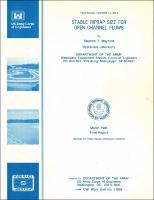Please use this identifier to cite or link to this item:
https://hdl.handle.net/11681/13288Full metadata record
| DC Field | Value | Language |
|---|---|---|
| dc.contributor.author | Maynord, Stephen T. | - |
| dc.date.accessioned | 2016-07-18T15:22:34Z | - |
| dc.date.available | 2016-07-18T15:22:34Z | - |
| dc.date.issued | 1988-03 | - |
| dc.identifier.uri | http://hdl.handle.net/11681/13288 | - |
| dc.description | Technical Report | - |
| dc.description | Abstract: Riprap revetment is one of the most widely used methods for protecting the boundaries of erodible channels, Determining riprap size is one of the most important steps in the desIgn process. Some of the existing methods for riprap sizing use the critical shear stress relations and the logarithmic velocity lavm to determine stable rip rap size. Flume data used in this investigation show that the use of a constant Shields coefficient in the critical shear stress relations is not valid for high relative roughness problems like riprap design. Similarly, the logarithmic velocity laws are not valid for high relative roughness problems. Another limitation of existlng riprap sizing methods is the lack of variation relative to the effects of gradation thickness, or shape. Using flume data, a riprap sizing method is developed based on average local velocity and depth. Variation in riprap gradation uniformity is described using D30 as the characteristic size. Thicker riprap blankets allow a reduction in size, and shape effects within the range tested are insignificant. Existing side slope relations used in the critical shear stress equation overestimate the decrease in stability that occurs when a particle is placed on a sloping bank. Comparison of velocity profiles over channel side slopes in straight and curved reaches shows that for the same average velocity over the toe of the side slope, the velocity and shear stress on the side slope are significantly higher on the outer bank of the curved channel. Depth and average velocity over the toe of the side slope are measured in straight and curved flume tests of rip rap stability and are used to develop sizing relations for side slope riprap. Results are compared to field data, and safety factors are recommended. A sizing nomograph and an example design are presented. | - |
| dc.publisher | Hydraulics Laboratory (U.S.) | - |
| dc.publisher | Engineer Research and Development Center (U.S.) | - |
| dc.relation | http://acwc.sdp.sirsi.net/client/en_US/search/asset/1003486 | - |
| dc.relation.ispartofseries | Technical report (U.S. Army Engineer Waterways Experiment Station) ; HL-88-4. | - |
| dc.rights | Approved for public release; distribution is unlimited. | - |
| dc.source | This Digital Resource was created from scans of the Print Resource | - |
| dc.subject | Channel stabilization | - |
| dc.subject | Erosion control | - |
| dc.subject | Revetments | - |
| dc.subject | Riprap design | - |
| dc.subject | Construction | - |
| dc.subject | Hydraulic structures | - |
| dc.title | Stable riprap size for open channel flows | - |
| dc.type | Report | en_US |
| Appears in Collections: | Technical Report | |
